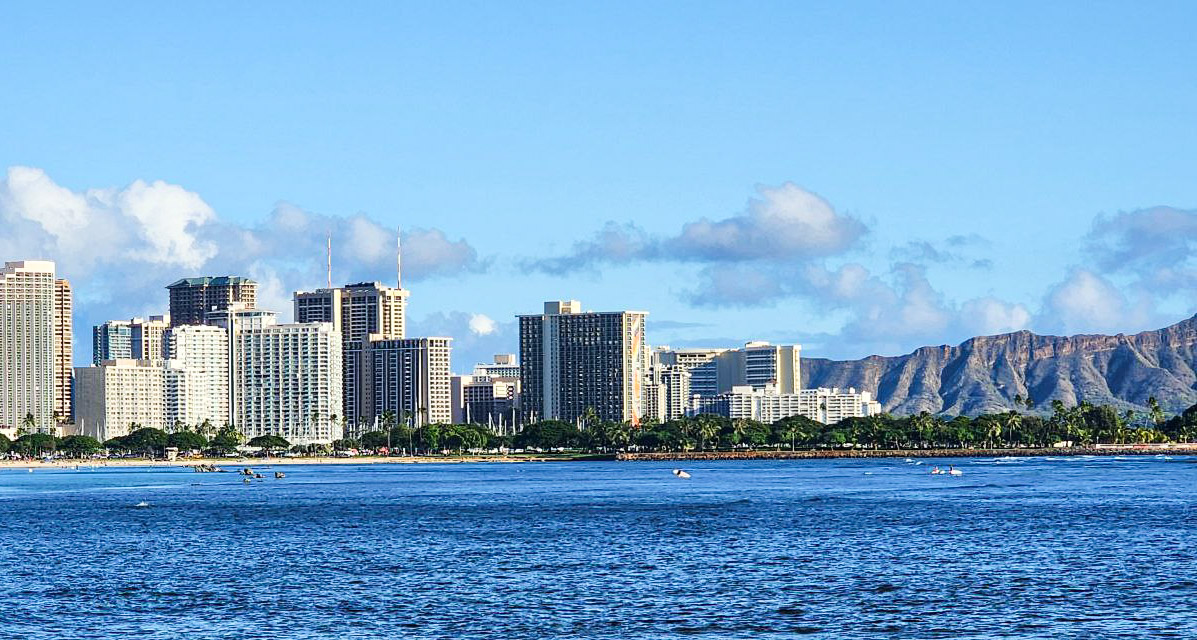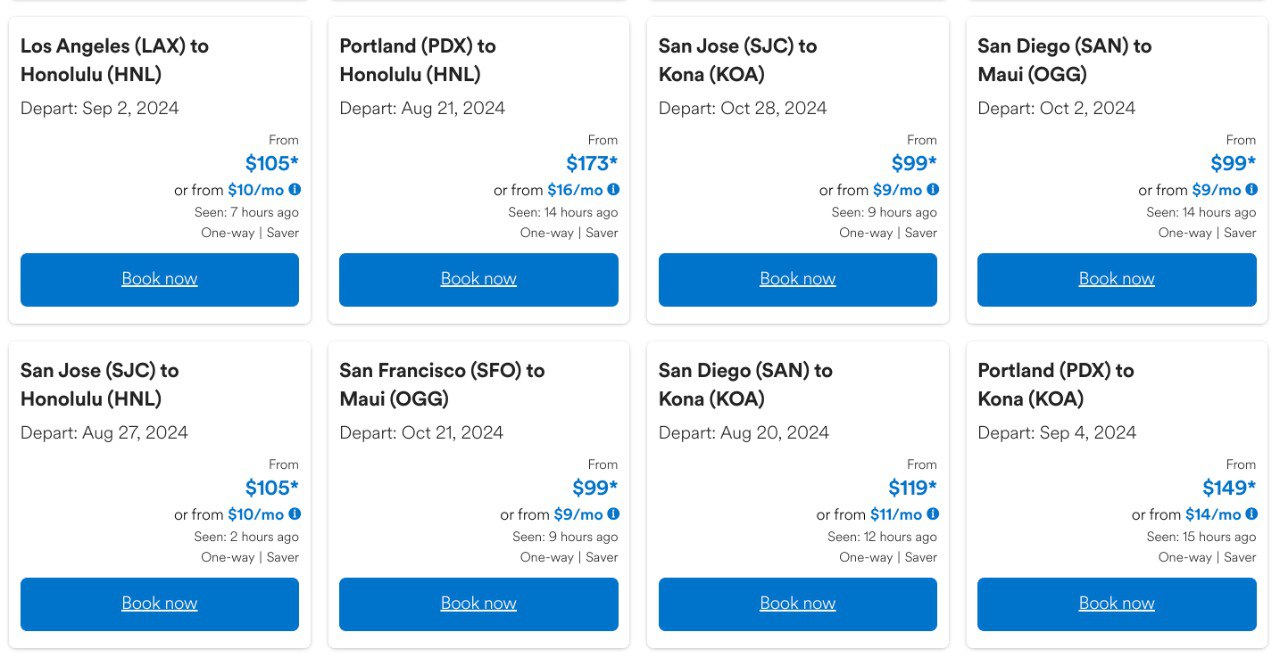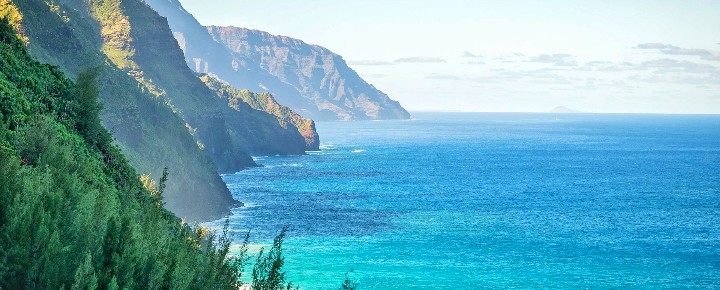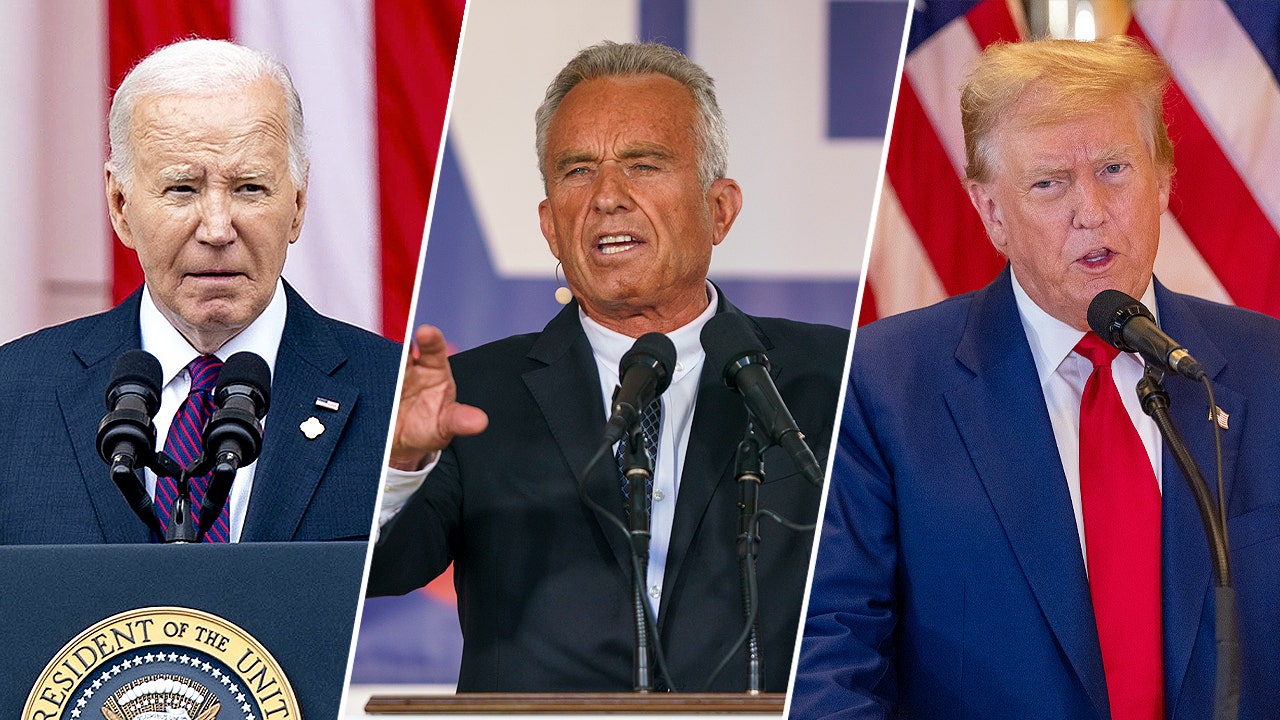Hawaii
New Alaska Air Tool Finds Cheapest Hawaii Flights From $99

A Hawaii airfare sale finder tool, either new or at least new to us, is something unique we discovered for finding the cheapest airfares to Hawaii on Alaska Airlines.
It currently features four routes from the mainland to Hawaii for under $100 and three more for just $105. The page lists specific dates on which these fares are available, from May through November. However, after checking further, we were able to find these same fares available on other nearby dates as well.

- San Diego to Honolulu $99
- San Jose to Kona $99
- San Diego to Maui $99
- San Francisco to Maui $99
- San Francisco to Honolulu $105
- Los Angeles to Honolulu $105
- San Jose to Honolulu $105
How does this work in relation to traditional Hawaii airfare sales and U.S. DOT requirements?
We will contact Alaska Airlines about this and report back with further details. This method of offering specific date and route deals appears to avoid U.S. DOT regulations on how airfare sales are promoted.


These are specific deals available and not a Hawaii airfare sale.
First, the DOT requires that any advertised airfare (which this appears to skirt) must be available in a reasonable quantity unless the advertisement clearly indicates a limited availability (which this does).
The DOT doesn’t specifically mandate a minimum number of seats or percentage of seats that must be available for an airline to promote an airfare sale. Airlines must nonetheless ensure that advertised prices are genuinely attainable in adequate numbers by consumers.


When sale airfares are available only under very limited conditions or in extremely limited quantities, this must be clearly communicated in the advertisement, as is the case here. This is intended to prevent “bait-and-switch” practices, where airlines could advertise a low price that is so limited in availability that it lures consumers into buying higher-priced yet more available fares.
Airlines must also adhere to DOT’s full-fare advertising rule, which says that any advertised fare must include all government-imposed taxes and mandatory fees, allowing consumers to see the total cost upfront.
One thing to note here is that the Alaska Airlines sale airfares shown, at least today, are Basic Economy, or the most restricted type. That will not appeal to many Hawaii visitors. Having said that, Alaska has the most generous rules associated with their Alaska Saver airfares.
What are your thoughts on this type of Hawaii airfare sale promotion?

Hawaii
Southwest flight makes “excessive descent” during go around in Hawaii | Flightradar24 Blog

Indian authorities are probing a loss of separation incident that occurred on 8 June in Mumbai. Air India flight 657 was cleared to depart Mumbai’s Runway 27 while IndiGo flight 5053 was cleared to land at the same time. According to ADS-B data received from both aircraft, at their closest point the flights were 1,671 apart.
Hawaii
Obituaries for June 15 – West Hawaii Today
Hawaii
A few midwives seek to uphold Native Hawaiian birth traditions. Would a state law jeopardize them?

HONOLULU — Ki‘inaniokalani Kahoʻohanohano longed for a deeper connection to her Native Hawaiian ancestors and culture as she prepared to give birth to her first child at home on the north shore of Maui in 2003.
But generations of colonialist suppression had eroded many Hawaiian traditions, and it was hard to find information on how the islands’ Indigenous people honored pregnancy or childbirth. Nor could she find a Native Hawaiian midwife.
That experience led Kahoʻohanohano — now a mother of five — to become a Native Hawaiian midwife herself, a role in which she spent years helping to deliver as many as three babies a month, receiving them in a traditional cloth made of woven bark and uttering sacred, tremorous chants as she welcomed them into the world.
Her quest to preserve tradition also led her into a downtown Honolulu courtroom this week, where she and others are seeking to block a state law that they say endangers their ability to continue serving pregnant women who hope for such customary Native Hawaiian births.
“To be able to have our babies in the places and in the ways of our kupuna, our ancestors, is very vital,” she testified. “To me, the point of what we do is to be able to return birth home to these places.”
Lawmakers enacted a midwife licensure law in 2019, finding that the “improper practice of midwifery poses a significant risk of harm to the mother or newborn, and may result in death.” Violations are punishable by up to a year in jail, plus thousands of dollars in criminal and civil fines.
The measure requires anyone who provides “assessment, monitoring, and care” during pregnancy, labor, childbirth and during the postpartum period to be licensed. The women’s lawsuit says that would include a wide range of people, including midwives, doulas, lactation consultants, and even family and friends of the new mother.
Ki’inaniokalani Kaho’ohanohano poses on Wednesday, June 12, 2024, in Honolulu. She is a Native Hawaiian cultural practitioner who is among those suing over a Hawaii law they say penalizes anyone who provides advice, information, or care, during pregnancy, birth, and postpartum who does not have a specific state license. Credit: AP/Jennifer Sinco Kelleher
Until last summer, the law provided an exception for “birth attendants,” which allowed Kahoʻohanohano to continue practicing Native Hawaiian birth customs. With that exception now expired, however, she and others face the licensing requirements — which, they say, include costly programs only available out of state or online that don’t align with Hawaiian culture and beliefs.
In 2022, the average cost of an accredited midwifery program was $6,200 to $6,900 a year, according to court documents filed by the state.
Attorneys for the state argued in a court filing that the law “undoubtedly serves a compelling interest in protecting pregnant persons from receiving ill-advice from untrained individuals.”
State Deputy Attorney General Isaac Ickes told Judge Shirley Kawamura that the law doesn’t outlaw Native Hawaiian midwifery or homebirths, but that requiring a license reduces the risks of harm or death.
Supporters of a lawsuit challenging a Hawaii midwife licensure law gather outside a courthouse in Honolulu on Monday, June 10, 2024. Credit: AP/Jennifer Sinco Kelleher

The dispute is the latest in a long history of debate about how and whether Hawaii should regulate the practice of traditional healing arts that dates to well before the islands became the 50th state in 1959. Those arts were banished or severely restricted for much of the 20th century, but the Hawaiian Indigenous rights movement of the 1970s renewed interest in the customary ways.
Hawaii eventually adopted a system where councils versed in Native Hawaiian healing certify traditional practitioners, though those suing say their efforts to form such a council for midwifery have failed.
Practicing midwifery without a license, meanwhile, was banned until 1998 — when, lawmakers say, they inadvertently decriminalized it when they altered the regulation of nurse-midwives, something the 2019 law sought to remedy.
Among the nine plaintiffs are women who seek traditional births and argue that the new licensing requirement violates their right of privacy and reproductive autonomy under Hawaii’s Constitution. They are represented by the Center for Reproductive Rights and the Native Hawaiian Legal Corporation.
“For pregnant people whose own family may no longer hold the knowledge of the ceremonial and sacred aspects of birth, a midwife trained in Native Hawaiian traditional and customary birthing practices can be an invaluable, culturally informed health care provider,” the lawsuit states.
When Kahoʻohanohano was unable to find a Native Hawaiian midwife to attend the birth of her first child, she turned instead to a Native American one, who was open to incorporating traditional Hawaiian aspects that Kahoʻohanohano gleaned from her elders.
She surrounded herself with Hawaiian cultural practitioners focusing on pule, or prayer, and lomilomi, a traditional massage with physical and spiritual elements. It all helped ease her three days of labor, she said. And then, “two pushes and pau” — done — the boy was born.
The births of her five children in various Maui communities, Kahoʻohanohano said, were her “greatest teachers” in herself becoming one of the very few midwives who know about Native Hawaiian birthing practices.
She is believed to be the first person in a century to give birth on her husband’s ancestral lands in Kahakuloa, a remote west Maui valley of mostly Native Hawaiians, where her daughter was born in 2015. The community is at least 40 minutes along winding roads to the island’s only hospital.
Kahoʻohanohano testified about helping low-risk pregnant women and identifying instances where she transferred someone to receive care at the hospital but said she’s never experienced any emergency situations.
Among the other plaintiffs are midwives she has helped train and women she has aided through birth. Makalani Franco-Francis testified that she learned about customary birth practices from Kahoʻohanohano, including how to receive a newborn in kapa, or traditional cloth, and cultural protocols for a placenta, including taking it to the ocean or burying it to connect a newborn to its ancestral lands.
The law has halted her education, Franco-Francis said. She testified that she’s not interested in resuming her midwifery education through out-of-state or online programs.
“It’s not in alignment with our cultural practices, and it’s also a financial obligation,” she said.
The judge heard testimony through the week. It’s not clear how soon a ruling might come.
-

 Movie Reviews1 week ago
Movie Reviews1 week agoStream It Or Skip It: ‘Under Paris’ on Netflix, a shark-in-the-Seine thriller that delivers the ludicrousness you crave
-

 News1 week ago
News1 week agoWoman handcuffed in police car hit by freight train reaches $8.5M settlement
-

 News1 week ago
News1 week agoIsrael used a U.S.-made bomb in a deadly U.N. school strike in Gaza
-

 World1 week ago
World1 week agoEconomy, migration: Voters' main concerns ahead of elections
-

 Politics1 week ago
Politics1 week agoTrump campaign accelerates vetting of potential running mates
-

 Movie Reviews1 week ago
Movie Reviews1 week agoShort Film Review: Blue and White (2022) by Hiroyuki Nishiyama
-

 World1 week ago
World1 week agoWorld leaders, veterans mark D-Day’s 80th anniversary in France
-

 World1 week ago
World1 week agoFrance to provide Ukraine with its Mirage combat aircraft
















